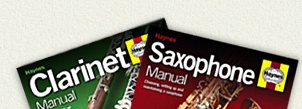Super Pennsylvania tenor saxophone (Yanagisawa T4)
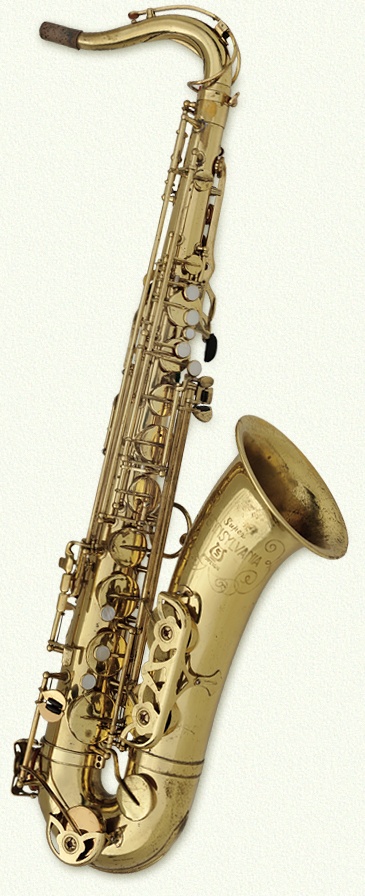 Origin:
Japan Origin:
Japan
Guide price: Not much
Weight: 3.33kg
Date of manufacture: 1976 (serial range: 176xxx)
Date reviewed: April 2020
More super than you might expect
Stencil horns - dontcha love 'em. Well yeah, in
general we do - because it means being able to buy a fairly decent
horn at a much reduced price due to not having a posh name on the
bell. And when it comes to the secondhand market it means that those
of us with a bit of 'insider knowledge' can sometimes spot a real
gem going begging that most people wouldn't give a second look.
For me though, at least with with my reviewer's hat on, they can
be a right old pain in the nether regions because it often means
having to trawl through blogs and forums in order to figure out
exactly what it is I'm looking at - and that's really not something
I enjoy. At all. So I was terribly pleased - nay delighted - when
this stencil horn handed me its credentials on a plate.
It's badged "Super Pennsylvania" - and
just below the name is the symbol of an S inside of a lyre. This
is the trademark of Selmer London - a company quite distinct from
Selmer Paris - which focussed more on distribution rather than the
manufacture of instruments. Thus its range of wind instruments were
bought in from a variety of manufacturers and rebadged.
I first encountered one of these back in the '70s when the girl
who played 2nd alto in my band spotted an ad in the local paper
for a Selmer alto at an incredibly low price - and asked if I'd
go with her to check it out. I was excited as she was as the prospect
of picking up what might have been a MkVI for a fraction of its
true value - so we were both bitterly disappointed when it turned
out not to be a Selmer Paris MkVI but a Selmer London Pennsylvania.
But what the hell, we were there...so I figured I might as well
try it, if only to be polite.
About 10 minutes later I told her to hand the money over. It was
a darling little alto (probably a Kohlert stencil) - and if she
hadn't have bought it, I would have.
If I remember rightly she played it for many years before swapping
it out for a 'real' Selmer.
Things would able all nice and rosy if Selmer
London had stuck to a single manufacturer - but as is so often the
case they pitched around for the best deal....which meant that the
Super Pennsylvania could be made by one manufacturer one year, and
a completely different one the next. Among the manufacturers who're
reputed to have made versions of this horn are Kohlert, Orsi and
Borgani.
This is all good and well, but it gets a bit tedious when you're
trying to nail down the origin of a horn by comparing design features
- such as the key guards or the bell brace - and life (for me) would
be so much simpler if they just stuck a little badge or a mark on
the horn.
And in this case they did.
 In
fact there are three clear pointers to the origin. In
fact there are three clear pointers to the origin.
The first can be found on the crook key - and in case you're in
any doubt at all, what you're looking at here is the logo of Yanagisawa.
This is great news! It's a Yani, right?
Well yeah...but which Yani? (I knew you'd ask).
This is a question that can often be as difficult to answer as "Who
made it?" given that Yanagisawa were notorious for chucking
out all kinds of variants under a single model number (take a look
at the review of the Yanagisawa
S6 soprano, for example) - so merely nailing down the manufacturer
was only half the job.
I needn't have worried though, because they've
very thoughtfully stamped the model number on the rear of the main
body tube.
You have the logo repeated - and the country of origin (which in
itself would narrow the field down to one of two manufacturers)
- and if you look to the left you'll see the number 4. This marks
the horn out as a Yanagisawa T4.
So we're all done here.
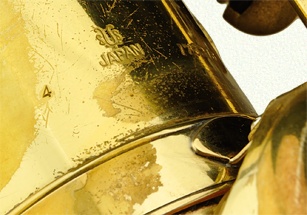 Well,
not quite - because (typically) there were reputed to have been
at least four major variants of the T4 over the years...and if my
experience of the company is anything to go by I suspect there may
well have been many more minor variations. Anyway, at this point
I gave up looking; I'd got my maker and model number - and that's
all I need. If you want to look into it in more detail knock, as
they say, yourself out and start with this
useful article on thesax.info... Well,
not quite - because (typically) there were reputed to have been
at least four major variants of the T4 over the years...and if my
experience of the company is anything to go by I suspect there may
well have been many more minor variations. Anyway, at this point
I gave up looking; I'd got my maker and model number - and that's
all I need. If you want to look into it in more detail knock, as
they say, yourself out and start with this
useful article on thesax.info...
 So
let's get down to the nuts and bolts... So
let's get down to the nuts and bolts...
The construction is single pillar (post to body), save for the palm
and side key pillars which use rather crude U-shaped cradles. The
pillar bases are, on the whole, of reasonable size. There's a detachable
bell, a positively humongous two-point bell stay ring (which in
itself is a bit of a giveaway as to the manufacturer), an adjustable
metal thumb hook, a flat plastic thumb rest and adjusters for the
bell key bumper felts. The toneholes are all of the plain drawn
type - and the overall construction of the body is suitably neat
and tidy.
During the course of the service I carried out
on the instrument, I had cause to do a spot of dentwork and tonehole
levelling - at which point I was surprised at how soft the brass
was. Actually, more than surprised - taken aback would be a better
description. A gentle tap with my tonehole mallet that should have
resulted in a minuscule drop in the level of the wall resulted in
a dip that then required lifting to bring the tonehole rim back
to level. I didn't make that mistake again.
I noticed this too on the key cups - many of which were warped and
so required levelling. I don't think it's the softest brass I've
seen on a horn (that would have been on an old Chinese Parrot alto...which
was practically made of butter), but it wasn't far short. However,
the key arms themselves seemed to be rather stiffer - which is really
where it matters.
There's a coat of clear lacquer on the horn, and it seems to be
on there well enough. I've seen comments that suggest that it didn't
hold up that long, but on this horn (at least) it's doing fine.
I had to resolder the guard foot in the shot above, and you can
see just how little of the lacquer was lost during the process.
 The
compound bell key pillar is of an 'interesting' design. The
compound bell key pillar is of an 'interesting' design.
The base is reassuringly large, but the pillar itself is just a
slab of brass fixed perpendicular to the base. There's almost no
strength in it at all in terms of resistance to being knocked back
(as it was) - but what really made me chuckle was the additional
plate that had been soldered onto the head of the pillar to add
a bit more meat for the point screws to sit in.
It's functional, I'll give it that - but pretty it ain't.
While we're here I might as well mention the point
screws. As you can probably see they're proper point screws of the
shoulderless variety, which means they're constantly adjustable
and will take up any wear and tear in the action with a mere turn
of the screw. About the only drawback to these type of screws is
that because they have no shoulder to them there's no mechanical
means of locking them in place - so a drop of threadlock is in order.
I usually recommend Loctite 222 (purple, weak strength) but you
can use a smear - and only a smear, on one side of the screw - of
Loctite 243 (blue, medium strength), which has the advantage of
being far more widely available and has a better tolerance of oil
contamination. Be advised that if you use too much of this stuff
it can make it very difficult to remove the screws (though heating
the pillar will help matters considerably).
I may as well mention the springs too, which are of the stainless
variety. They're excellent - and on no account should you consider
swapping them out for blued steel springs. The action has been designed
to accommodate their mechanical properties...so leave them well
alone. They won't rust, they're unlikely to break, they're very
tolerant of even quite clumsy tweaking and they'll like outlast
you and me both.
 That
just about wraps it up for the bodywork - save to mention the sling
ring. That
just about wraps it up for the bodywork - save to mention the sling
ring.
Well, it's not so much a ring as a staple. Nothing really wrong
with this design - and it may well even have some advantages over
the traditional ring, but I rather suspect it's been made this way
because it's cheaper to do so. It's of a decent size, so will accommodate
even the largest sling hooks.
And this is also a good shot of one of the U-channel
pillars - seen here holding the side Bb key. Like the staple sling
ring they're cheap and functional - though I tend to feel they look
a bit cheap 'n nasty (they were liberally used on late Weltklang
horns). With so little metal around the head and thread of the screw
they tend to wear out quite fast (which allows the rod screw to
rock, and thus the key) and it's very easy to strip the thread out
if you're a bit heavy-handed with a screwdriver.
Note the balljoint link on the Bb key. This is another feature I
don't much care for because it's prone to rapid wear - and when
it wears it becomes incredibly noisy and gives the key a rather
imprecise feel. You just can't beat a simple fork and pin link here.
 Here's
another balljoint, on the octave key mech. Here's
another balljoint, on the octave key mech.
Its use here is even more unwise than on the side keys because the
octave mech takes a hell of a beating - and swivel mechs can wear
quite quickly if not properly maintained. This makes the mech more
imprecise...and by the time you factor in the additional wear from
the balljoint it all gets a bit approximate over time.
And then it rattles like hell unless you keep it well lubricated
(which you usually don't, which is why it wears out in the first
place).
There's no tilting bell key table on this horn
- which, depending on your preference for such things, could be
a good thing or a bad thing.
I quite like a non-tilting table, so this goes down on my score
sheet as a plus. However, it's not the best example of the genre
I've encountered - and while it's entirely functional it's rather
less slick in action than I'd hoped for, and it gets a bit clunky
and vague when you're trying to whizz around it chromatically.
I'm not really sure why - each of the keys works well enough in
isolation (the C# has a fair bit of flex in it though) and there's
nothing really wrong with the layout...it's just that as a whole
it's a bit less than wonderful.
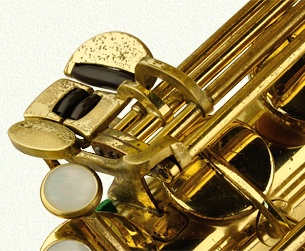 In
keeping with this basic approach there are few concessions for home
tweakers. In
keeping with this basic approach there are few concessions for home
tweakers.
You get a pair of adjusters over the G# and Bis Bb arm - and that's
your lot. Nothing on the main stacks, and nothing on the low B to
C# link. If you want to make any adjustments you'll have to get
busy with bits of cork and some sandpaper.
On the plus side you get a set of proper mother of pearl key touches
(all concave) - and on the minus side you might have noticed that
there's no top F# key on this horn. That's not such a big deal really
as it's a note that's readily available with a 'false fingering'
- typically octave key+front top F+A+side Bb. If that sounds a bit
flat you can substitute the Bis Bb for the A, which usually sharpens
it up.
And that, my friends, is about it. There really
isn't that much more to say about this horn - which really isn't
such a bad thing. It's quite a simple design, it's well made, it
doesn't really have any quirks to speak of - and there are few things
to point and laugh/frown at.
It's clearly an early(ish) design from Yanagisawa, which I think
shows up in the use of balljoints and the slightly clunky bell key
table (as compared to their later models) - but in its day it would
have been a lot better than most of the competition, and certainly
better built.
Likewise, there's little to say with regard to
how it feels in the hands. It's all nicely laid out, and the use
of long stainless steel springs give the action a very nice and
responsive feel. I really can't see many people struggling with
the action, save for those who like to dash around the bell notes.
It's also a reasonably light horn, which might be an important consideration
if you have a gyppy back - though if it comes in its original (and
heavy) box-style case you might well put your back out lifting the
thing in and out of the car.
So let's cut to the chase and see how well (or otherwise) this thing
plays....
 It's
an interesting blow. Tonewise it's immediately warm - which comes
as something of a surprise - and if that's not your cup of tea you
might be inclined to write it off as being stuffy. But it isn't.
Stuffy horns tend to have little definition, and not much response
either - but this one has plenty of both. It's
an interesting blow. Tonewise it's immediately warm - which comes
as something of a surprise - and if that's not your cup of tea you
might be inclined to write it off as being stuffy. But it isn't.
Stuffy horns tend to have little definition, and not much response
either - but this one has plenty of both.
Another characteristic of stuffy horns is that if you push them,
they simply won't play ball. But this one does; the more you put
into it, the thicker the tone becomes...until it gets quite booty
in that old '50s rock 'n roll style. You know, lots of mellow grunt
that you can feel in the pit of your stomach.
If you back off, though, it has a very gentle and considered approach
that borders on the wistful - and it maintains this tone no matter
how quietly you play...right into subtone, and even up until the
point where the note is just a whisper. It also has a lot of stability.
You can push and push this horn and it just won't crack the note.
Now, I said it's immediately warm - because if
you put a little time into getting your embouchure around the notes,
it starts to brighten up. Doesn't take long, maybe 15 minutes or
so - but little by little you begin to hear and feel a bit of shine
and glitter around the edges of the notes. I rather liked this,
it gives the impression that this is a horn that rewards anyone
who sticks around long enough to tease out the zip and zing rather
than just handing it to you on a plate from note 1. Even so, it
still retains a rather nice softness in its response.
Were it not for this feature I'd be inclined to mark this down as
a somewhat limited horn - but whether by accident or design it's
quite a quirky horn that will have a lot of appeal to those players
who don't much care for their tenors to be brash and shouty.
Back in the day this horn was built and sold for
the intermediate market, and I think that shows up in its playing
credentials. It doesn't quite have the clout of some of the more
expensive horns of the day, but it still puts on a good show - and
will still easily square up to many modern horns in the same category.
And there's a very good chance that any of the earlier T4 variants
will exhibit exactly the same playing characteristics, given that
the variations in design are almost certainly going to be related
to features rather than the body tube.
The best of it is that these stencil horns rarely
command high prices and can still be picked up very cheaply indeed.
Assuming, of course, that the seller hasn't read this review...
Addendum October 2022:
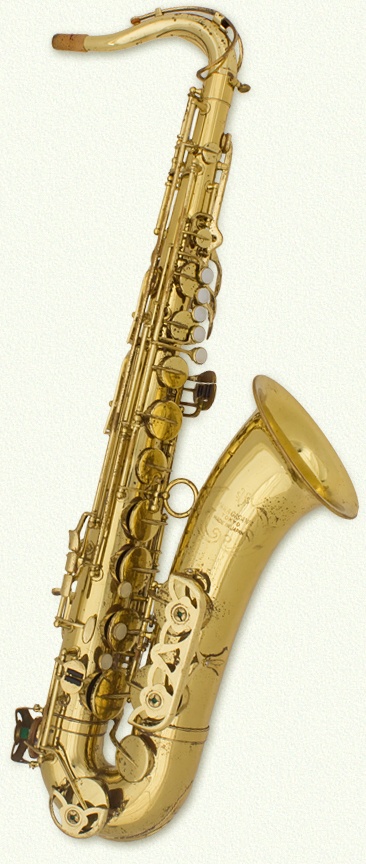 Had
an early T4 in for a service recently (serial range 669xxx), so
thought I'd take the opportunity to take a few shots and run through
some of the differences as compared to the above version. Had
an early T4 in for a service recently (serial range 669xxx), so
thought I'd take the opportunity to take a few shots and run through
some of the differences as compared to the above version.
 The
easiest difference to spot at a distance has to be the bell brace.
It's a dead giveaway. The
easiest difference to spot at a distance has to be the bell brace.
It's a dead giveaway.
On this version the brace ring is significantly smaller in diameter,
and the body mount is placed towards the centre of the body tube
- rather than off to the side on the later ones. If there's a practical
reason why you should go for the later variant over this one, it's
down to this feature - because a bell brace that's mounted near
the centre of the body tube can cause quite severe damage to the
tube and the adjacent toneholes if the horn takes a tumble.
If you look a little closer you can see that the brace is completely
fixed to the horn - there's no detachable bell on this variant.
Other immediately visible differences include
the layout of the top stack key pearls. Note the full-size pearl
for the Bis Bb key - and how in line the pearls are as compared
to the later versions.
The side or chromatic F# key down in the lower stack has a larger
touchpiece. Not sure why they did this because it's a lot more comfy
than the one on the later models, but I suspect it might have something
to do with the intention of fitting a top F# to subsequent models
and thus needing a bit more room.
Some of the difference are rather more subtle
- and/or hidden from view (at least in this view of the horn). One
such difference is the change from two-piece low B/Bb to single
piece keys.
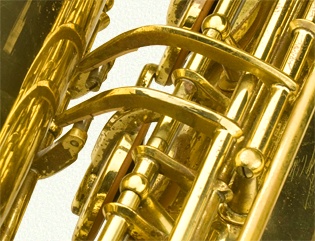 As
you can see, the low B/Bb cup keys are mounted on their own pivots
(fixed to the bell) and the keys are actuated by means of a pair
of separate levers. It's very much a throwback to the horns of yesteryear,
and as such it's not a terribly efficient mechanism. It takes great
care to minimise the friction between the lever arms and the cup
keys - though this is somewhat helped by the inclusion of a couple
of rollers where the keys meet. As
you can see, the low B/Bb cup keys are mounted on their own pivots
(fixed to the bell) and the keys are actuated by means of a pair
of separate levers. It's very much a throwback to the horns of yesteryear,
and as such it's not a terribly efficient mechanism. It takes great
care to minimise the friction between the lever arms and the cup
keys - though this is somewhat helped by the inclusion of a couple
of rollers where the keys meet.
Another vintage throwback is the C# key - which is a single-piece
key on this model. Again, it's not a very efficient design - and
the later variants sported a two-piece key.
Along with these changes came a different layout
and position of the bell key table, which made for a much more ergonomic
layout. It's not that the early model is particularly bad - it's
just that the later ones are that much slicker.
Another less obvious difference is the layout
of the octave key mechanism. The later variant has the now standard
two-piece key layout - but this example has the entire mech all
on one pivot.
In practical terms it makes little difference to the feel of the
mech, but it does make it a very great deal more vulnerable to knocks
and bashes.
 Some
of the smaller differences include plain and reliable fork and pin
connectors for the side Bb/C keys on this variant - as opposed to
the balljoint connectors that appeared later. Which Yanagisawa soon
- and very sensibly - reverted to plain forks and pins. It's a much
simpler action, and one that isn't prone to becoming loose and rattley
over time. Some
of the smaller differences include plain and reliable fork and pin
connectors for the side Bb/C keys on this variant - as opposed to
the balljoint connectors that appeared later. Which Yanagisawa soon
- and very sensibly - reverted to plain forks and pins. It's a much
simpler action, and one that isn't prone to becoming loose and rattley
over time.
And speaking of side keys, both the side Bb and C cup keys are mounted
on proper pillars on this model. Later models switched over the
the cheaper (and sadly rather less elegant) U-shaped cradles.
And I think that's about it for the differences,
other than to note that the early version weighs in slightly lighter
at 3.21kg.
As far as playing the horn goes, its tone is very
much the same as the later model. Without the two horns side-by-side
to compare it's impossible to pick out any nuances - and even if
it were there's a very good chance that they'd fall within the range
of differences you'll find on any two apparently identical horns.
If there were any changes to the bore/toneholes between the two
variants I suspect they'd be very minor ones.
In terms of which version to go for I would tend
to recommend the later one. The improvements to the action are well
worth having, both in terms of feel and reliability (side key balljoints
notwithstanding). It's also probably going to be the case that the
asking price between the models isn't going to be that much different
- and for the sake of a few quid extra you might as well have all
the bells and whistles. But if price is a concern, the early T4
is still a very decent horn.
|

